Keywords
Artificial intelligence; Brain-machine interface; Neural lace; Neuralink
Introduction
In 1943, neurologist Warren McCulloch and a youthful mathematician Walter Pitts composed a paper on how neurons may function; they displayed a straightforward neural organization with electrical circuits. In 1957, John von Neumann proposed straightforward neuron functions by using telegraph and vacuum tubes. Recently, research into neural networks has accelerated, and it is already being used to treat people with mental illnesses. Neuralink has pushed the boundaries of existing neural network research, not only curing patients but also connecting them to digital devices and assisting them in using these technologies without the need of any of their body parts through the use of a chip known as neuralink or the link [1].
Neuralink is a device that will be surgically implanted in your brain, allowing you to connect with and even control machines. It will also aid in the study of brain electrical impulses and the development of treatments to various medical problems. With neuralink, an 8 mm-diameter chipset called the N1 chipset will be implanted in your skull, with numerous cables containing electrodes and insulation for the wires. According to the firm, the wire is as thick as your brain's neurons and as thin as a strand of hair at 100 micrometres. To make a comparison, picture the diameter of your hair and multiply it by 10 [2].
The first major advancement is flexible "threads," which are less likely to harm the brain than current brain-machine interface materials. According to Elon Musk&Neuralink, these threads also make it possible to transport a larger amount of data. The device may have “as many as 3,072 electrodes per array spread over 96 threads,” according to the abstract [3].
Literature Review
However, because of its flexibility, neuralink's technology is more challenging to implant than the Utah Array. To address this issue, the company has developed “a neurosurgery robot capable of inserting six threads (192 electrodes) every minute,” (automatically). It resembles a hybrid between a microscope and a sewing machine in appearance. It also avoids blood arteries, possibly resulting in a reduced inflammatory response in the brain (Figure 1).
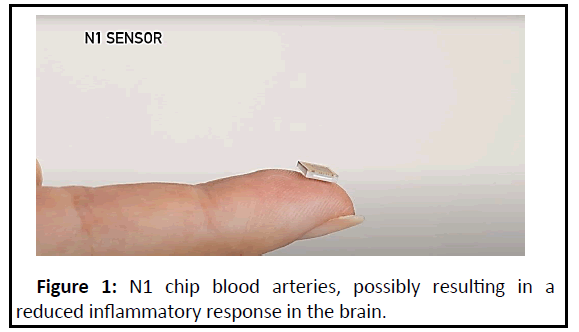
Figure 1: N1 chip blood arteries, possibly resulting in a reduced inflammatory response in the brain.
Brain machine interface
Brain Machine Interfaces (BMIs) or Brain Computer Interfaces (BCI) collect, analyse, and interpret brain signals into commands that are communicated to output devices that perform the desired activities. Normal neuromuscular output pathways are not used by Brain Computer Interfaces (BCI). The main goal of BCI is to replace or restore useful function to people disabled by neuromuscular disorders such as amyotrophic lateral sclerosis, cerebral palsy, stroke, or spinal cord injury [4].
Brain Machine Interfaces (BMI) or Brain to Machine Interface (B2M) have the potential to assist people with a variety of clinical problems, such as impaired sensory and motor functions, as well as connect us to any machine that can read our brain's inputs. For this, we need to have a high bandwidth rate.
BMI wasn't initially popular with clinical disorders because of the limited number of channels available for signal transmission, but they now have the potential to aid people with a wide range of clinical problems. Researchers have used no more than 256 electrodes to demonstrate human neuroprosthetic control of computer cursors, robotic limbs, and voice synthesizer (Figure 2).
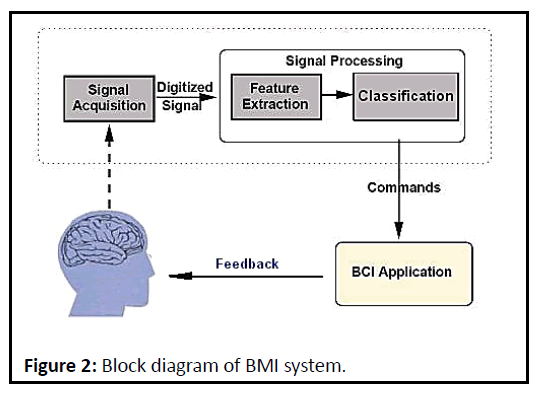
Figure 2: Block diagram of BMI system..
Although these successes suggest that high-fidelity information transfer between brains and machines is possible, development of brain-machine interface has been critically limited by the inability to record from large numbers of neurons.
How it works
As a result, our brain is made up of neurons that fire all the time in reaction to electrical messages received when we see, hear, move, talk, or think. Every time a neuron fires in response to these electrical signals, a little electromagnetic field is created. Neuralink will essentially tap into the brain's small electric fields generated by sinus junctions.
To detect these action potentials, tiny threads with electrodes that are about one-tenth the cross section of a human hair or roughly the size of a neuron are developed and injected into the brain. Each thread will be inserted by a robot to avoid bursting blood vessels or causing stress. The insertion needle is 24 microns in diameter, which is significantly smaller than the current state-of-the-art in deep brain stimulation.
The processor for making all of this work is called the n1 chip. The n1 chip amplifies, digitises, analyses, and transfers analogue brain signals captured by the threads to a pod device behind the ear. The pod device is the only thing that will be upgraded, and the implants will remain in place until the pod is removed and everything goes down. The n1 chip is a low-power 4 by 5 millimetre chip with built-in technology for processing brain data. It can read 20,000 brain samples per second, indicating that these are true raw signals from a neuralink attached to a brain.
Because the neural link comprises thousands of electrodes, it produces a cleaner, more dependable signal for more complicated applications. The neural link's first application will be to tap into the primary motor cortex, which is the part of the brain that sends signals down to the spinal cord and onto the muscles to drive movement. It will start with simple things like a mouse and keyboard, but it could also be used to read signals from all movement, including speech, and finally it could be used to restore movement in someone's own body (Figure 3). The materials or qualities that would cause the brain to not only accept but also believe that the neuralink is a part of it [5].
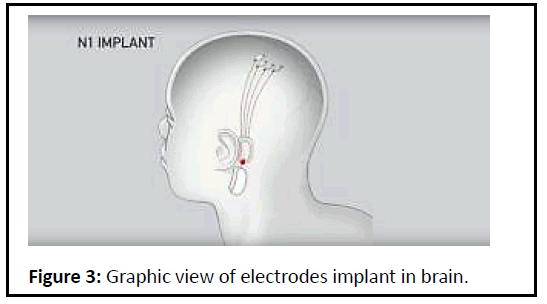
Figure 3: Graphic view of electrodes implant in brain..
Implant process (Robot)
Since we're talking about drilling a hole in your skull and putting cables into your brain, many people are sceptical. Musk has stated that the process is complicated and beyond the capability of even the most expert human hands. That's why neuralink will put the device into the brain with the help of specially built robots. The business stated that it will carry out the operation in compliance with health ministry rules to ensure the operation's safety [2].
Tiny threads with electrodes (about the size of a human hair) are designed to be injected into the brain to detect these action potentials. A remotely driven neurosurgical robot infuses each of these threads. The insertion needle used by the robot is around 24 microns in diameter, which is significantly smaller than the current state of the art for Deep Brain Stimulation (DBS). According to ColdFusion, similar surgeries for Deep Brain Stimulation (DBS) for Parkinson's patients have been performed in the past, but with ten electrodes and a much larger needle. Traditional procedures, on the other hand, have a one -in-a hundred chance of inducing a major brain haemorrhage (Figure 4).
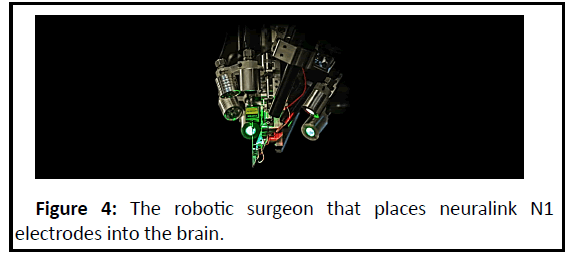
Figure 4: The robotic surgeon that places neuralink N1 electrodes into the brain.
Neuralink not only reduces the potential of brain damage by using microscopic threads, but it also opens up the option of collecting massive amounts of data by employing not 10, but thousands of electrodes [6].
This robot is capable of performing the precise movements required to implant the threads into your brain. It may appear to be a straightforward process, but at the scale of the threads, it becomes a task almost as difficult as properly landing a space rocket back on Earth-a problem Musk is all too familiar with [7].
These things are really, really small. You really can’t manipulate them with your hand. The threads are peeled off one at a time by the robot to place into the brain. So we had to build a surgical robot (Figure 5). The surgery is not possible without the robot.”- Max Hodak, President of neuralink [8-10].
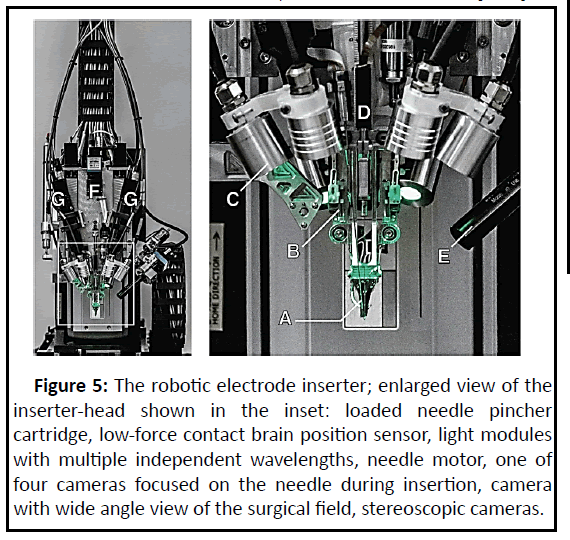
Figure 5: The robotic electrode inserter; enlarged view of the inserter-head shown in the inset: loaded needle pincher cartridge, low-force contact brain position sensor, light modules with multiple independent wavelengths, needle motor, one of four cameras focused on the needle during insertion, camera with wide angle view of the surgical field, stereoscopic cameras..
Discussion
Components
The robot’s insertion head is mounted on a globally accurate, 400 × 400 × 150 mm travel, 10 μm three-axis stage and holds a small, quick-swappable “needle-pincher” assembly.
The needle is milled from 40 μm diameter tungsten-rhenium wire-stock electrochemically etched to 24 μm diameter along the inserted length the tip of the needle is designed both to hook onto insertion loops-for transporting and inserting individual threads-and to penetrate the meninges and brain tissue. The needle is driven by a linear motor, allowing variable insertion speeds and rapid retraction acceleration (up to 30,000 mm/s2) to encourage separation of the probe from the needle. The pincher is a 50 μm tungsten wire bent at the tip and driven both axially and rotationally. It serves as a support for probes during transport and as a guide to ensure that threads are inserted along the needle path (Figure 6).
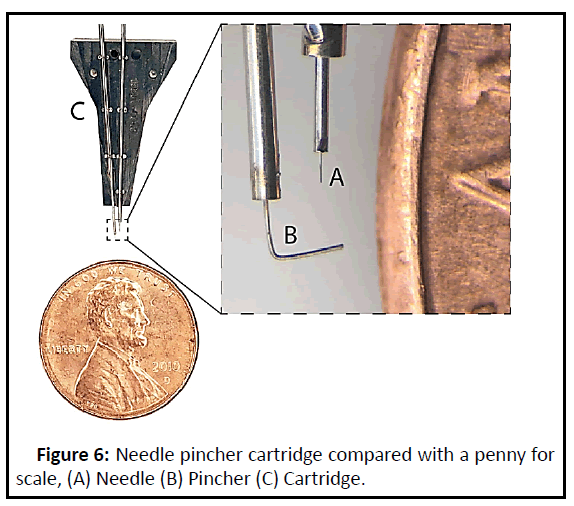
Figure 6: Needle pincher cartridge compared with a penny for scale, (A) Needle (B) Pincher (C) Cartridge..
Advantages of neuralink
There are two types of pros
Short-term with a first-generation device on the motor cortex and long-term with later-generation devices anyplace on the cortex:
• Ability to control a computer with your mind helping shut in people with sever paralysis communicates.
• Explore the ability to observe high-results neuronal activity in real-time to see why individuals perform activities. Could be extremely useful in gaining a better understanding of cortical circuits.
Longer term with later generations of the same technology elsewhere on the cortex:
• A neural shunt allowing paralyzed people to regain control of their bodies.
• High precision mental control of machines.
• Brain to brain telepathy.
• Body swapping via a sort of neural telepresence.
• Recording of incoming sensory information.
• Ultimately a way to back up your mind although this would need to go deeper than just the cortex.
Disadvantages of neuralink
• Brain surgery though less risky than we might think if conducted with precision under sterile conditions.
• Some unknown long term impact on the brain from decomposition by the body of the electrode materials over time.
• A Bluetooth device that is controllable by a digital computer connected direct to your brain. The security better be amazing.
• They touched upon the need for regular upgrades, brain surgery every couple of years?
Conclusion
After the utah array neuralink is another and upgraded breakthrough in neural engineering. Neuralink may be the bridge that connects human beings to the next level of artificial intelligence but many people might have reservations on a computer chipset inside their brains. The neuralink is successfully implanted in pig but as of now, the technology has not been tested on humans. The vision of this technology can be fulfilled when neuralink is successfully implanted in humans. Neuralink can be the biggest invention/researches of the century if it is successfully implanted in humans. Neuralink chip also study the electrical signals in the brains and arrive at solutions that can help to cure so many lives suffering from neural disabilities or various medical problems.
41958
References
- Kulshreshth A, Anand A, Lakanpal A (2019) Neuralink- An Elon Musk Start-up Achieve symbiosis with Artificial Intelligence. International Conference on Computing, Communication, and Intelligent Systems (ICCCIS) 2:105-109.
- Cyrus John (2020) Neuralink Explained: How We Will Talk To Machines Using Our Brain. The Quint.
- Elizabeth Lopatto (2019) Elon Musk unveils Neuralink’s plans for brain-reading ‘threads’ and a robot to insert them. The Verge.
- Shih JJ, Krusienski DJ, Wolpaw JR (2012) Brain-computer interfaces in medicine. Mayo Clinic proceedings 87:268-279.
- Joana Stockmeyer (2019) Neuralink-Are Brain-Computer Interfaces leading us into a technological utopia?. Master of Media.
- Kenny L (2019) What Is Neuralink: A Look At What It Is, What It Wants to Be, and What It Could Become.
- Musk E, Neuralink (2019) An Integrated Brain-Machine Interface Platform With Thousands of Channels. J Med Internet Res 21:1-10.
- Kołodziej M, Majkowski A, Rak R (22010) Matlab FE-Toolbox-An universal utility for feature extraction of EEG signals for BCI realization. Przeglad Elektrotechniczny 86:44-46.
- Joshua Bakely (2020) Elon Musk “Neuralink” Startup will enable Human Brain to operate Computers and Smartphones just by Thinking.











